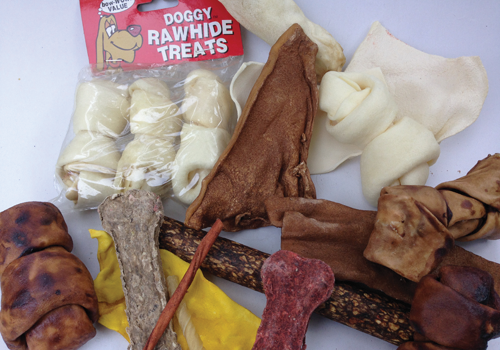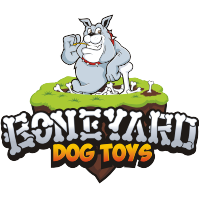Soft natural toys designed for chewing
There are now thousands of rawhide chew products on the market. But beyond rawhide, there are now chew toys made from all manner of animal parts and from an expanding list of animals.
For most dog's, a soft natural chew toy will be at the top of their chewing list. The soft chews include rawhide, ears, bully sticks, trachea and more.
Similar to the hard natural chews, there are pros and cons to all of these.

A selection of rawhide chew toys
How to make soft natural chew toys a part of your dog's chew toy variety
Chewing is a natural activity for your dog. Chewing helps them to relax and when used as a positive reinforcement for good behavior, obedience training becomes a pleasurable activity.
Although these chew toys are hard and inflexible when purchased, they don't stay that way for long once your dog gets a hold of them. These types of chew toys originated from soft tissues of other animals and become pliable when chewed. This means your dog will in short order be able to chew off pieces. This can will lead to a very dangerous situation.
Supervision, especially when introducing your dog to a new type of chew toy is very important. Watch how your dog chews on soft chew toys. A dog's saliva very quickly softens rawhide. Are they an aggressive chewer or a gentle chewer?
Many dogs are very capable of chewing off small pieces of soft natural chew toys. When swallowed, these pieces can become choking hazards. The key to feeding your dog soft chews is knowing how to select the safest types and when to remove the pieces that are too small.
Size selection is crucial here. Do not give a large dog a small rawhide.
A safer alternative are the rawhide products that are made from a pulvarized rawhide and then pressed into various shapes. These chews can easily be chewed into small digestible bits.
Similar to using a bone or other hard natural chew toy during training, a soft natural chew can also be an integral part of your crate training, bed training or any time you want to promote quiet time for your dog. Just remember, do not leave your dog chewing on a soft chew for an extended period of time. Supervise.
Again, confirming the country of origin for any of these chew toys is advisable if you want to minimize the risk of exposing your dog to unwanted toxins and preservatives.
Natural soft chews
Discussion of many different types of soft natural chews
Rawhide shapes ranging from loops and twists to sticks and chips.
Commercial availability of rawhide processed as a chew treat for dogs began in the 1950's. The rawhide used for dog chews is processed from the inner lining of the cow's hide. The outer layer is used for commercial leathers.
Keep in mind, rawhide chews that are uniformly white with little coloring are processed with chemicals to remove the color. Outside the United States, chemicals are used to initially clean the hide. Usually this will include bleach or hydrogen peroxide. The hide may then be preserved using arsenic or formaldehyde. In addition, traces of lead, mercury, chromium salts, insecticides, antibiotics and even Salmonella have been reported in dog chew rawhide. These methods are banned in the United States, so the safest practice is to stick with "Made in the USA" rawhide.
The quality of the hide also has a lot to do with how the animal is raised, whether it is free range or not. Not every country has the same standards for what is fed to the livestock and that can influence what types of chemicals are present in the hide.
Finally, some of the rawhide chews available have been smoked or flavored. Most dogs love the flavoring, but for some dogs this results in diarrhea.
Is rawhide safe for dogs as a chew toy?
The answer depends in part on your dog. Again, if you have an aggressive chewer, probably not. More often than not, when the rawhide they're chewing becomes a small piece or they're able to tear off a piece, their tendency is to swallow it whole which becomes a possible choking hazard.
Because rawhide is very pliable until it is dried, manufacturers form the pieces into all varieties of shapes. Often, small stick forms will have a knot at each end. Dogs zero in on the knots and chew them off which then become choking hazards.
If you do plan to serve up rawhide as a chew for your dog, be sure to select the thickest rolled rawhide. The thicker the hide the higher the quality and the safer it is for your dog. Pick rolls that look like they are a single thick sheet rolled up. Avoid those with decorative knots or what may appear as smaller pieces rolled inside the outer roll. These pieces will become dislodged as your dog chews and may end up as choking hazards.
If rawhide is a must for your dog, there are a number of products on the market that are made of pressed rawhide. Now instead of tearing off large pieces of undigestible rawhide that are then swallowed, the pressed bones are chewed down gradually, more like a bone. This is because the pressed bones are made from hide that has been ground into a pulp and then machine pressed under high pressure into shapes.
A couple things to bear in mind, the hides used for pressed bones are generally lower grade hides. This can just mean the hide was thinner or discolored. Also, pressed rawhide bones are generally not manufactured in the USA, but more likely India, China, Korea, Thailand and South America.
Its good to keep in mind that very little (a few percent) of the rawhide consumed is actually digested.
There are rawhide alternatives. The No-Hide Dog Chews by Earth Animal look and feel like rawhide but are instead an easily digested (80% digestible based on a recent study) composition of natural ingredients that chew just like rawhide. It should be pointed out that Earth Animal manufactures all their products in Blue Ball, Pennsylvania within a USDA certified food processing plant. These all natural chews are made of Beef, Chicken
or Salmon
flavors. If you're looking for more of a snack item, try the stix which also come in Beef
, Chicken
, and Salmon
varieties.
The bully stick has become a very popular soft natural chew toy. Sometimes referred to as pizzle sticks, these are the penis from cattle. Usually they come from either the United States or South America, but more recently from Australia, New Zealand and India. The general recommendation is stick to bully sticks that are from free range cattle sourced from either South America or the USA.
Redbarn Pet Products has been producing bully sticks for over 20 years. They source and process all their bully sticks from their own plant in Paraguay in order to assure the best quality.
The bull penis is mostly muscle (think protein) and tendon which is why it makes such a good chew toy. Its digestible. If the fluids are properly drained during processing the bully stick will be odor free. It is then stretched and sometimes braided with multiple pieces or left straight
, dried or smoked and then cut into lengths.
Because the processing requires no chemical treatments, contaminents in bully sticks are low and more about how the livestock were raised.
The final product is a single narrow stick of varying lengths. There is a general consensus that dogs chew only from one or both ends. What makes bully sticks a great chew toy is that dog's have a difficult time chewing off pieces. They also do not shatter or splinter. So, as long as you choose lengths and diameters that are matched to your dog and you remove the bully stick once it becomes too small to chew safely, it is a relatively safe chew toy.
Pig ears are relatively new to the commercial dog chew menu. Unlike the bully sticks which are composed of mostly muscle and tendon, pig ears are very high in fat. This is probably why they are popular with dogs.
When processed properly, they are dried or smoked
at high temperatures before adding flavorings like bacon. If not, there is a high potential for Salmonella contmination. Several brands a few years ago were recalled for this reason. Stick to "Made in the USA" to minimize this risk.
Because pig ears are very high in saturated fats, dogs at risk for obesity or pancreatitis should avoid these. The high fat content also makes it harder to digest the ears so diarrhea is often a problem.
As with many of the soft chews, your dog may be able to tear off large pieces that are then swallowed without chewing them up. Therefore, supervision is important when giving your dog a pig ear to chew on.
Another new comer to the soft natural chew list are trachea, sometimes referred to as Moo Tubes. Typically these come from cattle sourced from either South America or the United States. They are attractive to many because they are hollow and can be stuffed with additional treats.
The biggest risk associated with this type of chew toy is choking. The material is very thin and as dog's begin chewing it they are able to tear off pieces that are large enough to present as choking hazards when swallowed whole.
Keep a watchful eye on your dog if you use these chews.
Sign up for our FREE report.
"What Trainers Say About Using Toys During Training"
To receive a digital copy of our 15-page report, click on the eReport image above. The book covers some interesting applications of toys used by dog trainers to reinforce behaviors.
Your email address is totally secure and will only be used to send you the report.


